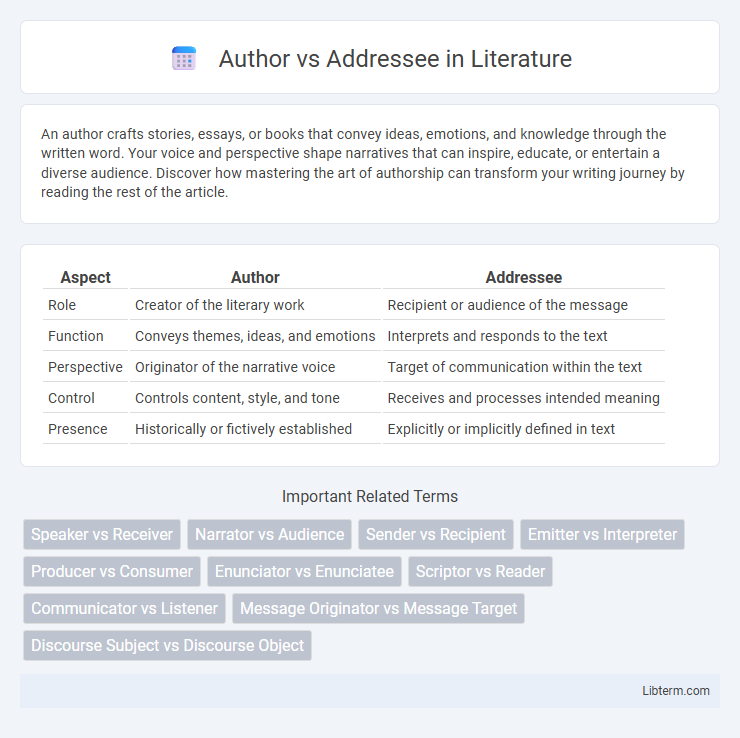An author crafts stories, essays, or books that convey ideas, emotions, and knowledge through the written word. Your voice and perspective shape narratives that can inspire, educate, or entertain a diverse audience. Discover how mastering the art of authorship can transform your writing journey by reading the rest of the article.
Table of Comparison
| Aspect | Author | Addressee |
|---|---|---|
| Role | Creator of the literary work | Recipient or audience of the message |
| Function | Conveys themes, ideas, and emotions | Interprets and responds to the text |
| Perspective | Originator of the narrative voice | Target of communication within the text |
| Control | Controls content, style, and tone | Receives and processes intended meaning |
| Presence | Historically or fictively established | Explicitly or implicitly defined in text |
Understanding the Roles: Author vs Addressee
Understanding the roles of author and addressee is crucial in effective communication, with the author being the creator of the message and the addressee the recipient who interprets it. The author encodes thoughts into language, intending to convey specific information or emotions, while the addressee decodes these signs to grasp the underlying meaning. This dynamic interaction influences clarity, tone, and context, shaping how messages are constructed and received.
Defining the Author: Creator and Initiator
The author serves as the creator and initiator of a text, shaping its content, style, and purpose through intentional choices. This role encompasses originating ideas, structuring narratives, and embedding meaning to engage the addressee effectively. Defining the author involves recognizing their authority and responsibility in crafting messages that influence interpretation and response.
The Addressee: Target Audience and Receiver
The addressee refers to the target audience or receiver of a message, whose characteristics and needs influence the way content is crafted and communicated. Understanding the addressee involves analyzing demographics, preferences, and context to ensure the message resonates effectively and prompts desired responses. Tailoring communication strategies to the addressee enhances clarity, engagement, and overall impact of the message.
Purpose and Objectives of the Author
The author's purpose centers on conveying information, expressing ideas, or persuading the addressee to adopt a specific viewpoint or take action. Objectives often include clarifying concepts, influencing attitudes, or eliciting responses that align with the author's intent. This dynamic shapes the communication strategy, ensuring the message resonates effectively with the addressee's expectations and needs.
Expectations and Needs of the Addressee
The Addressee's expectations and needs shape the communication strategy, requiring the Author to tailor content for clarity, relevance, and engagement. Understanding the Addressee's background, interests, and goals allows the Author to address specific concerns and provide valuable information effectively. Meeting these expectations enhances the message's impact and fosters meaningful interaction between Author and Addressee.
Communication Dynamics: Author to Addressee
The communication dynamics between author and addressee center on the intentional transfer of meaning from the author to the receiver, where the author encodes a message shaped by context and purpose. Effective interaction depends on the author's ability to anticipate the addressee's knowledge, expectations, and interpretive frameworks to ensure clarity and engagement. This bidirectional awareness facilitates semantic precision and adaptive messaging, enhancing comprehension and response within the communicative exchange.
Influence of Context on Author-Addressee Relationship
The influence of context on the Author-Addressee relationship shapes communication dynamics, affecting tone, formality, and message interpretation. Social, cultural, and situational factors determine how the author constructs the message and how the addressee perceives and responds to it. Contextual nuances drive the adaptability of language use, reinforcing or modifying roles and expectations between author and addressee.
Style, Tone, and Voice: Shaped by Audience
The style, tone, and voice of a text are critically shaped by the relationship between the author and the addressee, as authors tailor their language to meet the expectations and knowledge level of their audience. Formal and technical jargon often characterize writing aimed at expert addressees, whereas conversational and emotive tones prevail when addressing a general or lay audience. Understanding the demographic and psychographic attributes of the addressee enables the author to craft a voice that resonates effectively, ensuring clear communication and emotional engagement.
Challenges in Author-Addressee Interaction
Challenges in author-addressee interaction often arise from misaligned expectations and differing interpretations of the message. Variations in cultural backgrounds, language proficiency, and communication styles can lead to misunderstandings and reduce the effectiveness of the exchange. Ensuring clarity, context, and feedback mechanisms are essential to overcome these barriers and facilitate successful communication.
Enhancing Engagement Between Author and Addressee
Enhancing engagement between the author and addressee requires clear and relatable communication tailored to the addressee's interests and needs, fostering a connection that encourages active participation. Utilizing personalized language and addressing specific concerns increases the relevance of the message, thereby boosting reader engagement and comprehension. Interactive elements such as questions, calls to action, and feedback opportunities strengthen the dialogic relationship, making the communication more dynamic and impactful.
Author Infographic

 libterm.com
libterm.com